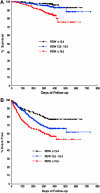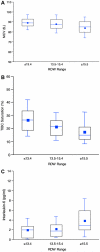Validation and potential mechanisms of red cell distribution width as a prognostic marker in heart failure
- PMID: 20206898
- PMCID: PMC3894681
- DOI: 10.1016/j.cardfail.2009.11.003
Validation and potential mechanisms of red cell distribution width as a prognostic marker in heart failure
Abstract
Background: Adverse outcomes have recently been linked to elevated red cell distribution width (RDW) in heart failure. Our study sought to validate the prognostic value of RDW in heart failure and to explore the potential mechanisms underlying this association.
Methods and results: Data from the Study of Anemia in a Heart Failure Population (STAMINA-HFP) registry, a prospective, multicenter cohort of ambulatory patients with heart failure supported multivariable modeling to assess relationships between RDW and outcomes. The association between RDW and iron metabolism, inflammation, and neurohormonal activation was studied in a separate cohort of heart failure patients from the United Investigators to Evaluate Heart Failure (UNITE-HF) Biomarker registry. RDW was independently predictive of outcome (for each 1% increase in RDW, hazard ratio for mortality 1.06, 95% CI 1.01-1.12; hazard ratio for hospitalization or mortality 1.06; 95% CI 1.02-1.10) after adjustment for other covariates. Increasing RDW correlated with decreasing hemoglobin, increasing interleukin-6, and impaired iron mobilization.
Conclusions: Our results confirm previous observations that RDW is a strong, independent predictor of adverse outcome in chronic heart failure and suggest elevated RDW may indicate inflammatory stress and impaired iron mobilization. These findings encourage further research into the relationship between heart failure and the hematologic system.
Copyright (c) 2010 Elsevier Inc. All rights reserved.
Figures


Similar articles
-
Red cell distribution width as a novel prognostic marker in heart failure: data from the CHARM Program and the Duke Databank.J Am Coll Cardiol. 2007 Jul 3;50(1):40-7. doi: 10.1016/j.jacc.2007.02.067. Epub 2007 Jun 18. J Am Coll Cardiol. 2007. PMID: 17601544
-
Red cell distribution width in heart failure: prediction of clinical events and relationship with markers of ineffective erythropoiesis, inflammation, renal function, and nutritional state.Am Heart J. 2009 Oct;158(4):659-66. doi: 10.1016/j.ahj.2009.07.024. Epub 2009 Aug 26. Am Heart J. 2009. PMID: 19781428
-
Relation of Red Cell Distribution Width to Left Ventricular End-Diastolic Pressure and Mortality in Patients With and Without Heart Failure.Am J Cardiol. 2017 May 1;119(9):1421-1427. doi: 10.1016/j.amjcard.2017.01.036. Epub 2017 Feb 10. Am J Cardiol. 2017. PMID: 28285713 Free PMC article.
-
Red Blood Cell Distribution Width is a Biomarker of Red Cell Dysfunction Associated with High Systemic Inflammation and a Prognostic Marker in Heart Failure and Cardiovascular Disease: A Potential Predictor of Atrial Fibrillation Recurrence.High Blood Press Cardiovasc Prev. 2024 Sep;31(5):437-449. doi: 10.1007/s40292-024-00662-0. Epub 2024 Jul 20. High Blood Press Cardiovasc Prev. 2024. PMID: 39031283 Review.
-
The diagnostic and prognostic value of red cell distribution width in cardiovascular disease; current status and prospective.Biofactors. 2019 Jul;45(4):507-516. doi: 10.1002/biof.1518. Epub 2019 May 30. Biofactors. 2019. PMID: 31145514 Review.
Cited by
-
Elevated levels of RDW is associated with non-valvular atrial fibrillation.J Thromb Thrombolysis. 2014 May;37(4):404-10. doi: 10.1007/s11239-013-0957-1. J Thromb Thrombolysis. 2014. PMID: 23821044
-
Red cell distribution width and early mortality in elderly patients with severe sepsis and septic shock.Clin Exp Emerg Med. 2015 Sep 30;2(3):155-161. doi: 10.15441/ceem.15.037. eCollection 2015 Sep. Clin Exp Emerg Med. 2015. PMID: 27752590 Free PMC article.
-
Assessment of red blood cell distribution width as a prognostic marker in chronic lymphocytic leukemia.Oncotarget. 2016 May 31;7(22):32846-53. doi: 10.18632/oncotarget.9055. Oncotarget. 2016. PMID: 27147570 Free PMC article.
-
Red cell distribution width is associated with short-term mortality in critically ill patients with heart failure.ESC Heart Fail. 2022 Oct;9(5):3210-3220. doi: 10.1002/ehf2.14023. Epub 2022 Jun 29. ESC Heart Fail. 2022. PMID: 35768950 Free PMC article.
-
Study on the Red Blood Cell Distribution Width in Connective Tissue Disease Associated with Interstitial Lung Disease.Biomed Res Int. 2020 Jan 24;2020:8130213. doi: 10.1155/2020/8130213. eCollection 2020. Biomed Res Int. 2020. PMID: 32047815 Free PMC article.
References
-
- Al-Ahmad A, Rand WM, Manjunath G, Konstam MA, Salem DN, Levey AS, et al. Reduced kidney function and anemia as risk factors for mortality in patients with left ventricular dysfunction. J Am Coll Cardiol. 2001;38:955–62. - PubMed
-
- Horwich TB, Fonarow GC, Hamilton MA, MacLellan WR, Borenstein J. Anemia is associated with worse symptoms, greater impairment in functional capacity and a significant increase in mortality in patients with advanced heart failure. J Am Coll Cardiol. 2002;39:1780–6. - PubMed
-
- Mozaffarian D, Nye R, Levy WC. Anemia predicts mortality in severe heart failure: the prospective randomized amlodipine survival evaluation (PRAISE) J Am Coll Cardiol. 2003;41:1933–9. - PubMed
-
- Ezekowitz JA, McAlister FA, Armstrong PW. Anemia is common in heart failure and is associated with poor outcomes: insights from a cohort of 12 065 patients with new-onset heart failure. Circulation. 2003;107:223–5. - PubMed
-
- Felker GM, Gattis WA, Leimberger JD, Adams KF, Cuffe MS, Gheorghiade M, et al. Usefulness of anemia as a predictor of death and rehospitalization in patients with decompensated heart failure. Am J Cardiol. 2003;92:625–8. - PubMed
Publication types
MeSH terms
Substances
Grants and funding
LinkOut - more resources
Full Text Sources
Other Literature Sources
Medical
Research Materials
Miscellaneous

